The last oddball at the Indianapolis Motor Speedway
Part 4: Performance evaluation (2)
Author
- Henri Greuter
Date
- December 16, 2008
Related articles
- March-Porsche 90P - The last oddball at the Indianapolis Motor Speedway, by Henri Greuter
- Introduction
- Part 1: About oddballs
- Part 2: The road towards the 90P
- Part 3: The design
- Part 4: Performance evaluation (1)
- Part 6: Final reflections
- Part 7: Specifications
- Part 8: Results
- Part 9: Insights about the 90P from one of its designers
- March-Alfa Romeo 90CA - Fiasco Italo-Brittanico, by Henri Greuter
- Porsche - Weissach's single Grand Prix win, by Mattijs Diepraam/Felix Muelas
Who?Teo Fabi What?March-Porsche 90P Where?Indianapolis When?1990 Indianapolis 500 |
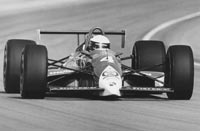 |
Why?
Two reworked 90Ps were present at Indianapolis during the first week of practice. Stiffening the suspension assemblies all around turned out to be a major improvement and the cars and the cars did show some competitive speeds.
Pole Day was rained out and only two thirds of the original qualifying line had been able to make its granted shot for the pole on Sunday, May 13. Among them was John Andretti who was 6th fastest when qualifying had to be ended. His uncle and nephew (Mario and Michael) were 5th and 4th fastest, making it an entire Andretti 2nd row for the time being! John was positive about his car for the race, praising handling and engine torque in particular.
Indianapolis 1990: 90P(ancake) the last ever Indy oddball
Eventually, with qualifying finished, John ended up 10th on the grid. Teo Fabi lost his opportunity to become a first-day qualifier and a shot for the pole when his engine blew in one of the practice sessions prior to qualifying. Teo even went back into a backup 89P!

Tiny mechanics were needed to manoeuvre the car in Gasoline Alley! (photo HG)
The team effectively used the time in the second week of practice to tune in their new cars while a third car was also delivered and test-driven by both Andretti and Fabi.

The Porsche Indy V8 sans car, this is likely the 89P version. The backup cars in 1990 were updated 89Ps with their own engines. Turbo hardware wasn't interchangeable because of the different location of the turbo in both cars: it was behind the engine on the 89P but in front of the engine on the 90P. Since this is the front part of the engine and the inlet plenum doesn't show the intake, it's likely to be at the back side of the plenum on this engine. That means the turbo was on that flywheel side as well. So this must be an 89P engine. (photo HG)
During the second weekend of qualifying, Fabi handsomely made the field but since he was a second-day qualifier, he was positioned behind the designated first-day qualifiers, way down the field. Nevertheless, Fabi was still the fastest non-Ilmor-Chevy qualifier in the field, with Andretti the second fastest. Moreover, Fabi was the only non-Chevy driver who qualified at a speed over 220mph. Knowing the cars were overweight and reportedly lacked straightline speed, their Speedway aerodynamics were definitely impressive when it came to cornering speeds.
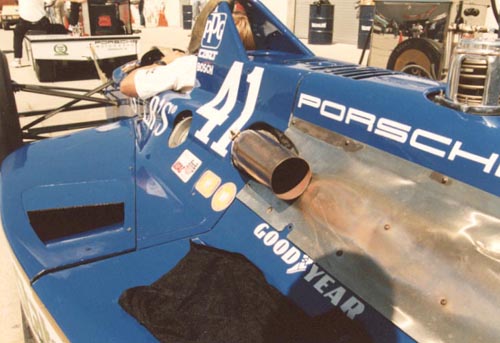
The exhaust pipe installed - look how narrow the radiator exits are. Also visible in this shot is the upper surface of the sidepod. The sidestep in the monocoque at fuel-tank level is clearly visible. (photo HG)
Andretti had impressed a number of onlookers both in and outside the team during all of the testing sessions with the car. It was felt that despite all the problems the Porsche team had made lots of progress after the difficult start of the season. Some rated the Porsches as dark horses for the race itself.

Teo Fabi returns to the pits after qualifying his car for the race on Saturday May 19. (photo HG)
It was a remarkable detail on the March-Porsche, compared to other cars, that their side pods didn't have the horizontal upward fins attached to shade the rear wheels. (I have read these devices being called the 'Ligier whoops' since the disastrous 1984 Ligier CART machine was the first to employ them.) All Lolas and Penskes had such appendages, the only other cars not using them were the Alfa Romeo-powered March 90CAs. Later on in the year such fins did appear on the 90P on several occasions.

A 90P with the engine installed. (photo HG)
On Race Day, neither of the two drivers could make much of an impression, both retiring in what proved to be the fastest ever 500 miles race in history to that date. John Andretti spun off on lap 136 while Teo Fabi retired on lap 162 with transmission problems. Up until then Teo had worked his way up to a highest position of 8th behind the Chevrolet-powered cars but even by then running several laps behind the leaders. John was among the backmarkers within the 'Bowtie Brigade' prior to spinning out. Yet it was something of an approval that behind the Chevy brigade the 90P-Porsche was one of the best, if not the best of the rest. The race was spoiled with just four yellows, Johnís spin caused the last yellow.

The third 90P appeared on track late in the second week of practice. Maybe the SR71 Blackbird inspired the jet-like 90P to run with an unpainted nosecone? Or was it the Dale Coyne-entered Lola T90/00 that ran in unpainted matt-black stealth bodywork for a number of days? (photo HG)
Being Dutch, my disappointment about the Porsche result was gone when I saw fellow countryman Arie Luyendijk win the race in a record speed, unmatched ever since.
The remainder of the season
Ever since the 90P's debut the Porsche team had been struggling to get rid of the overweight. Another problem cited for the car was that, due to the compact sidepods the airflow through them wasn't optimal, causing some problems with overheating the engine and its systems.7
The low-line, track-hugging car gave its drivers a real pounding on every track that wasn't as flat as a pool table. During practice sessions at Detroit, both Fabi and Andretti suffered from fuel vaporisation troubles, a problem credited to the car being such a tight package. One week later at Portland the team struggled with problems with the oil systems, gearboxes and a rough ride. All season long the team kept modifying and improving the cars in order to lose weight and improve performance. But time and opportunity to do some decent prolonged testing, like for example at Indianapolis, was hardly present.
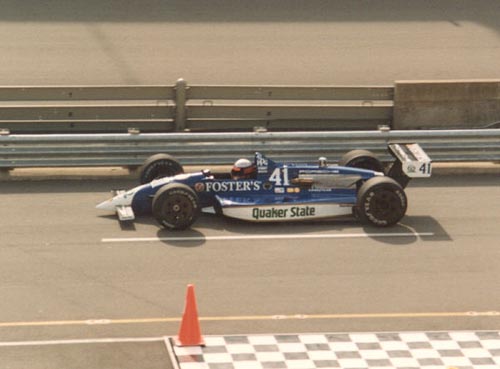
90P in the pitlane. Other than that unusual exhaust pipe the car looks fairly normal - low but elegant. (photo HG)
Only in the second half of the season the car finally reached the minimum weight limit and it began to work. Results, however, were mediocre. Cleveland was yet another bumpy ride for the Porsche drivers although Fabi managed a decent 9th starting spot. Andretti then continued to surprised in the race with a hard-fought 5th place, the best result of the season up until then.
Meadowlands was even better with Fabi 6th fastest in practice, and Andretti 12th. Both ran good races, circling in 3rd and 4th place for a while until John crashed out with 9 laps to go. He was still classified 7th. Teo finished 3rd!
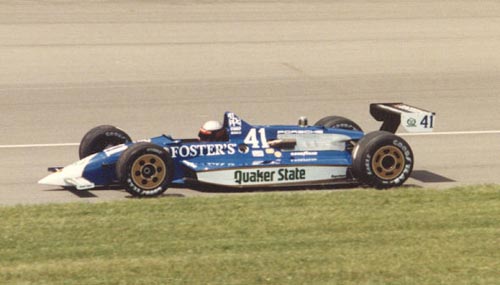
Andretti on Carb Day. (photo HG)
One week later saw a decent qualifying result at Toronto, once again showing signs of promise. In a race held in a downpoor neither John nor Teo would finish in the points.
By that time there were rumors that the future of the team was in doubt, Porsche wanting to concentrate on the F1 engine and future GpC projects. But there was talk about the Indy V8 remaining available and the current Derrick Walker-led team continuing as a private team with independent sponsorship.
With all this uncertainty going on, Michigan, the second 500-miler of the season took place. This event saw decent qualifying results once again for the team though both drivers reported large changes in handling from full to low-fuel tanks. John brought his car home in 7th, 16 laps down on the winner, Teo retired due to the bad handling.
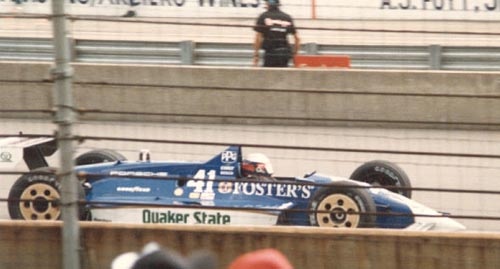
An Indianapolis race day picture of John. Sorry, but that's the best I could manage that day! (photo HG)
Porsche was still undecided on what to do and during the weekend of Denver it became known that team director Derrick Walker was trying to keep the team intact and keep on using the Porsche Indy V8. Though in what kind of car and where the money to fund the project came from was still unknown. The exclusive deal with March to built cars was set to be lost, as was the Foster's sponsorship. In these circumstances the team saw the must unlikely result of the season: Teo Fabi taking pole on a street circuit! A major weight reduction, finally getting close to the minimum weight limit, was among the reasons of this competitive showing. In the race Teo succumbed to the pressure of a challenging Mario Andretti on lap 7 and crashed out, but John Andretti saved the day with 6th place.
During their careers the cars did not change dramatically in appearance other than the installation of high-downforce rear wings and the use of horizontal sidefins on the sidepods like the Penskes and Lolas were using. One major difference in appearance at the end of the season was the exposure of the rollbar framework which before had been covered as if integrated within the bodywork. And occasionally the cars ran with green starting numbers instead of white ones.
Around late August, early September there were some talks by Porsche hotshot Helmut Flegl who reportedly negotiated with two teams about supplying the Porsche V8 engine to them but both teams were unable to cover the costs of the engine program. During the Vancouver weekend, Porsche announced its withdrawal from CART. Derrick Walker was permitted to try to keep the team together and go on but without the support of Porsche. Vancouver as an event itself, a bumpy track, meant yet another pounding for the drivers. Their race was partly compromised when both Fabi and Andretti lost half a lap during a yellow. John still managed to finish 5th, Teo finished outside the points.
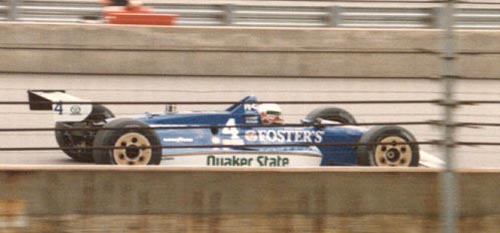
Fabi at speed during the race. (photo HG)
During all on-going publicity about Porsche's racing future, Fabi was mentioned several times as being involved in the development of Porsche's V12 F1 engine.
Road America saw the drivers qualify 8th and 10th but race day brought zero luck: both were out of the race after 12 laps. At Nazareth the best news was that Andretti qualified 10th but then he retired early. Fabi qualified 22nd but still finished 11th.
Having won a pole that season Fabi also qualified for participation in the multi-dollar, 100-lap Marlboro Challenge held the same weekend. It was a waste of effort since out of the 10 lucky guys at the start Fabi finished 9th, beating only Eddie Cheever, who retired.
Porsche's CART swansong was one of the better races of the season, Teo and John qualifying 8th and 9th and each finishing one spot higher in the race. In the final championship positions John Andretti ended up 10th in the standings, Fabi was 14th. It was the end of a project with a difficult start, a year of promise and setbacks, and a mission unfulfilled.
Epilogue
The last race for the March 90Ps also became March's final CART outing. While the Pancake hadn't been quite the hoped-for success, the Alfa Romeo-powered 90CA was such a catastrophic device that Patrick Racing and Alfa ditched the Marches halfway into the season to buy Lolas. During the first half of the 90s the manufacturing of CART chassis appearing at Indianapolis was divided between Penske and Lola, each having their spells of success and crushing failures. Newcomers Truesport (not very successful), the continuation of that project, the R/H (no success, ask Bobby Rahal!), Reynard (very successful) and Galmer (just two victories, but one of them at Indianapolis in 1992!) were all cars built according to the general design of the day, meaning that there weren't any genuine oddballs left.

The end. Fabi's car pulled from the pitlane in retirement. Little did we realize at that time that these were the last-ever moments of a Porsche at the hallowed Speedway. (photo HG)
At Indianapolis the IRL rules have effectively banned the oddball. The prescribed specification chassis and engines eliminated all opportunity to create something different, making the 1990 March-Porsche 90P Indy's last-ever oddball, at least for the time being.
Additional pictures
Mark Windecker took these pictures of the 90P at Detroit:
